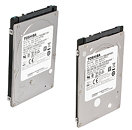- Joined
- Oct 9, 2007
- Messages
- 47,204 (7.56/day)
- Location
- Hyderabad, India
| System Name | RBMK-1000 |
|---|---|
| Processor | AMD Ryzen 7 5700G |
| Motherboard | ASUS ROG Strix B450-E Gaming |
| Cooling | DeepCool Gammax L240 V2 |
| Memory | 2x 8GB G.Skill Sniper X |
| Video Card(s) | Palit GeForce RTX 2080 SUPER GameRock |
| Storage | Western Digital Black NVMe 512GB |
| Display(s) | BenQ 1440p 60 Hz 27-inch |
| Case | Corsair Carbide 100R |
| Audio Device(s) | ASUS SupremeFX S1220A |
| Power Supply | Cooler Master MWE Gold 650W |
| Mouse | ASUS ROG Strix Impact |
| Keyboard | Gamdias Hermes E2 |
| Software | Windows 11 Pro |
Toshiba Corporation's Semiconductor & Storage Products Company announced the launch of its new solid state hybrid drive (SSHD) series, which is equipped with Toshiba's 19nm second-generation NAND flash memory. The new "MQ02ABD100H" SSHD offers 1TB capacity in a drive 9.5mm high, while the "MQ02ABF050H" offers a capacity of 500GB in a 7 mm high form factor. Sample shipments will begin from February.
SSHDs deliver better performance compared to traditional hard disk drives (HDD), because the drives feature NAND that is used as the secondary cache during operation. This means users see improvement to the drive's performance compared to traditional HDDs, while still maintaining the equivalent capacities of traditional HDDs. The "MQ02ABD100H" and "MQ02ABF050H" are suitable for high-performance PCs like mainstream and gaming PCs, while the "MQ02ABF050H"'s height of 7mm makes it suitable for ultra-thin and ultra-portable computing devices.

Toshiba's new generation SSHDs merge the NAND controller function into the main HDD controller chip. This all-in-one system on chip (SoC) for the "MQ02ABD/ABF-H" series enables more integrated management of the HDD and NAND operation compared to previous Toshiba SSHDs ("MQ01ABD-H" and "MQ01ABF-H" series) that featured separate NAND and HDD controller chips. With its engineering expertise and experience, Toshiba combines its NAND, HDD and SSD technologies to develop and produce SSHDs. Toshiba's NAND controller technologies unleash the NAND capabilities such as defective block management, ECC (Error Correction Code), conversion of logical block address and wear-leveling.
The new generation SSHDs also offer compatibility in both physical size and interface with traditional 2.5-inch HDDs. In other words, SSHDs allow for improved physical space efficiency within a system compared to alternatives that use a discrete SSD cache drive alongside an HDD. When using SSHDs, systems can access the drive through a single interface without the need for specific device driver software. Because it is a single unit, the SSHD is a lower cost alternative to SSDs while offering similar performance.
View at TechPowerUp Main Site
SSHDs deliver better performance compared to traditional hard disk drives (HDD), because the drives feature NAND that is used as the secondary cache during operation. This means users see improvement to the drive's performance compared to traditional HDDs, while still maintaining the equivalent capacities of traditional HDDs. The "MQ02ABD100H" and "MQ02ABF050H" are suitable for high-performance PCs like mainstream and gaming PCs, while the "MQ02ABF050H"'s height of 7mm makes it suitable for ultra-thin and ultra-portable computing devices.

Toshiba's new generation SSHDs merge the NAND controller function into the main HDD controller chip. This all-in-one system on chip (SoC) for the "MQ02ABD/ABF-H" series enables more integrated management of the HDD and NAND operation compared to previous Toshiba SSHDs ("MQ01ABD-H" and "MQ01ABF-H" series) that featured separate NAND and HDD controller chips. With its engineering expertise and experience, Toshiba combines its NAND, HDD and SSD technologies to develop and produce SSHDs. Toshiba's NAND controller technologies unleash the NAND capabilities such as defective block management, ECC (Error Correction Code), conversion of logical block address and wear-leveling.
The new generation SSHDs also offer compatibility in both physical size and interface with traditional 2.5-inch HDDs. In other words, SSHDs allow for improved physical space efficiency within a system compared to alternatives that use a discrete SSD cache drive alongside an HDD. When using SSHDs, systems can access the drive through a single interface without the need for specific device driver software. Because it is a single unit, the SSHD is a lower cost alternative to SSDs while offering similar performance.
View at TechPowerUp Main Site



